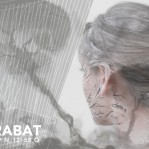Krabat 55° 39′ N, 13° 53′ O
By Divina Hasselmann Audio-visual interactive instrument;
Audio-visual interactive instrument;
The installation explores the impossibility of approximating a place through digital devices in contrast to the physical material experience in a place. At the same time it critically engages with the amazement for new media technology as a form of magic, and draws attention to the uncanny of mechanical instruments.
The Sorbian Saga ‘Krabat’ serves as the center and connector for these various elements. In this tale, the young Krabat works in a mill under a master who practices black magic. Krabat can only break the master’s magic by relying on his lover’s non-visual senses. She needs to step closer to sense his body in order to identify and release him from the magic.
Installation:
One projector will throw abstracted map images on the front of the installation, which merge on the strings with the video from the back. Analogous to Krabat, the audience will need to break through the circle of the abstract and distant fascination for visual effects, by stepping closer to the installation and physically engaging with the instrument. In doing so, their bodies will become part of the piece, blocking the front projection and making the projection from the back visible: A video essay illustrating the intimate engagement with the materials used and touched by the miller every day, shot in a rhythmic way resembling the millers work routine. It thus creates two experiences, the digital as the more familiar, and the mechanical instrumental as the uncanny magical, while attempting to overcome the binary and merge them into one piece.
The projection will be most visible at evening or night time, thus emphasizing the notion of the “Unheimliche”(in the Freudian Sense) and the black magic of the saga.
The installation will be realized in collaboration with Thais Ribeiro.
Bio:
Divina Hasselmann is a media artist and filmmaker based in New York City and Hamburg, with background in theater – film and media studies, linguistics and political science. She implements complex contemporary theories around the notions of simulation, the body, language, death and hybridity into her film and media works, trying to give a response to these very ideas in a different format, as well as making them more accessible to the public.

